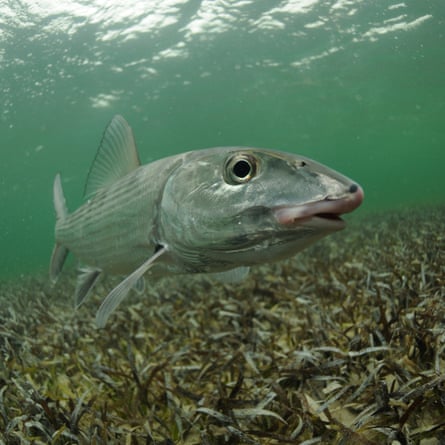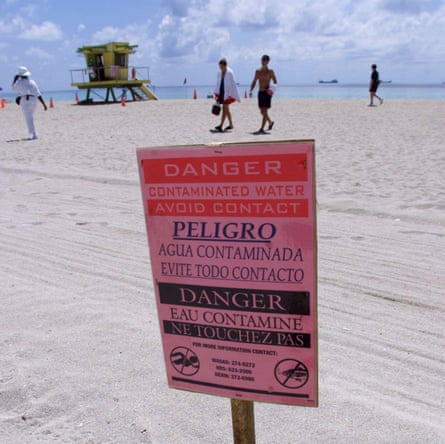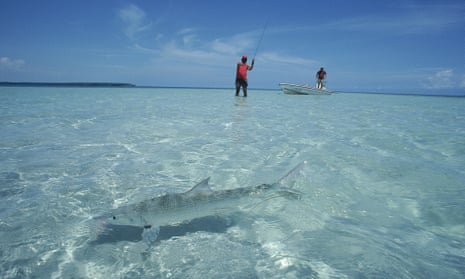Nicknamed “grey ghosts” for their lustrous silver scales, remarkable stealth and speed, bonefish can swim at up to 40mph. This species, protected by catch-and-release laws in the US, is revered by anglers around the world, many of whom visit Florida to seek the elusive fish.
But evidence points to a steep drop in bonefish numbers in south Florida. Populations have fallen more than 50% over four decades, according to estimates by researchers.
Dr Jennifer Rehage, a fish ecologist and associate professor at Florida International University (FIU), has spoken to many anglers about the fish’s disappearance from Florida’s seagrass flats: “They’ve said to me: ‘I’ve fished [bonefish] all my life and I can’t find them. I haven’t seen a bonefish in five years, and it’s freaking me out’.”
For the past three years, Rehage has been leading a study to find out why, and has discovered something that might help explain it: pharmaceuticals.

Of the 93 bonefish she and her team sampled, all tested positive for at least one pharmaceutical, including heart medications, opioids, antifungals and antidepressants, according to the results of the study, published in February.
In 56% of fish, researchers detected pharmaceutical quantities at levels “above which we expect negative effects”, according to the study. One bonefish sampled in Key West tested positive for 17 pharmaceuticals – eight of them antidepressants that were up to 300 times above the human therapeutic level. Pharmaceutical exposure in south Florida’s bonefish was “widespread and concerning”, the study concluded.
The researchers also studied 125 animals that bonefish prey on, including shrimp, crabs and small fish. Each contained an average of 11 pharmaceutical contaminants, indicating that the contamination is not limited to bonefish.
While more is known about the potential impacts of pharmaceutical pollution in freshwater, marine impacts have been far less studied. There is still not enough information to directly link bonefish decline with drugs, but “the potential for pharmaceuticals to be a problem [for fish in the sea] is formidable and concerning”, Rehage says.
Nearly 5bn medications are prescribed annually in the US alone, and the average American has about 12 prescriptions a year. Pharmaceuticals reach the water in various ways, including through manufacturing and rainwater run-off, but human and livestock wastewater is one of the main causes – especially what humans send down the toilet.
The specific health consequences of pharmaceutical contamination on marine life are not yet fully understood but there is evidence of multiple negative effects.
“[It] can provoke several consequences, mainly on the behaviour of fish, but it can also affect their ability to reproduce and their endocrine system,” says Elena Fabbri, a professor at the department of biological, geological and environmental sciences at Bologna University in Italy.
In 2013, scientists from Umeå University in Sweden – which partnered with FIU on the bonefish study – found that wild perch were less fearful and more antisocial when exposed to anti-anxiety medications, which could affect feeding and breeding. A 2016 study by the same university found salmon exposed to this medication swam faster and had riskier behaviour. Crayfishes’ exposure to antidepressants has been linked to altered behaviour, increasing their boldness and the time they spent foraging, potentially making them more vulnerable to predators.
There are three main ways wastewater ends up in the sea, says Rachel Silverstein, director of the environmental organisation Miami Waterkeeper: sewage spills, discharge of treated wastewater into the ocean and malfunctioning septic tanks. These have all been major problems in Florida. In 2020, 212m US gallons (800m litres) of sewage spilled into Fort Lauderdale’s waterways.
“Though most contamination is screened out at sewage treatment plants, it’s very hard to remove some of these pharmaceuticals from the water,” Silverstein says. In addition, more than half of the septic tanks in Miami-Dade county are not filtering waste properly due to rising sea levels, creating an environmental and public health hazard, she says.

Silverstein sees FIU’s study as “further evidence that we need to make urgent changes to upgrade our infrastructure to continue living in this region and protecting our economic and environmental interests”.
The problem is not limited to Florida. Experts say there is an urgent need to improve wastewater infrastructure globally to remove pharmaceuticals before they reach the ocean.
Implementing an additional step in wastewater management known as “ozonation” could help, Rehage says. The technique adds ozone to the water to help remove contaminants that are often missed by traditional wastewater treatment, including pharmaceuticals and pesticides. But not enough countries are retrofitting plants to incorporate this step, she says, pointing to Switzerland, Sweden and Germany as among the only countries “that are actually dealing with this issue of pharmaceuticals”.
Improved wastewater management is important, but the pharmaceutical industry itself also has a responsibility to tackle the issue by exploring greener alternatives, Fabbri says. “We cannot ban these substances because we need them, but we could favour or push pharmaceutical industries to find greener alternatives.” This could include producing drugs that break down faster in the environment.
There are political moves to understand more about the impact of drugs on waterways. In 2019, for example, the EU adopted a “strategic plan” to address the risks from pharmaceutical pollution in the environment. But many such initiatives focus more on the impact on freshwater environments.
As further research points to the impact of pharmaceuticals in the ocean, Fabbri says: “We must continue publishing about this subject to inform regulatory agencies that there is a need for these regulations in marine environments as well.”
For now, researchers say there is a long way to go in the US. “The control of chemicals entering our environment has always been reactive,” says Aaron Adams, director of science and conservation at the Bonefish & Tarpon Trust, the conservation organisation that commissioned the FIU study.
“No legal limits exist for the control of pollution from pharmaceuticals during manufacture, use nor disposal,” the report noted.
Nick Castillo, a PhD student at FIU and co-author of the study, says standardised metrics are needed to assess the effects of drugs on exposed organisms. Currently, he points out, these “antiquated” environmental regulations tend to ignore pharmaceuticals “because they aren’t lethal”.
Studying the impacts of pharmaceuticals in waterways has always focused heavily on freshwater, Rehage says: “This is one of the first studies to go into marine coastal environments and over a large area to show that pharmaceuticals are everywhere.”
